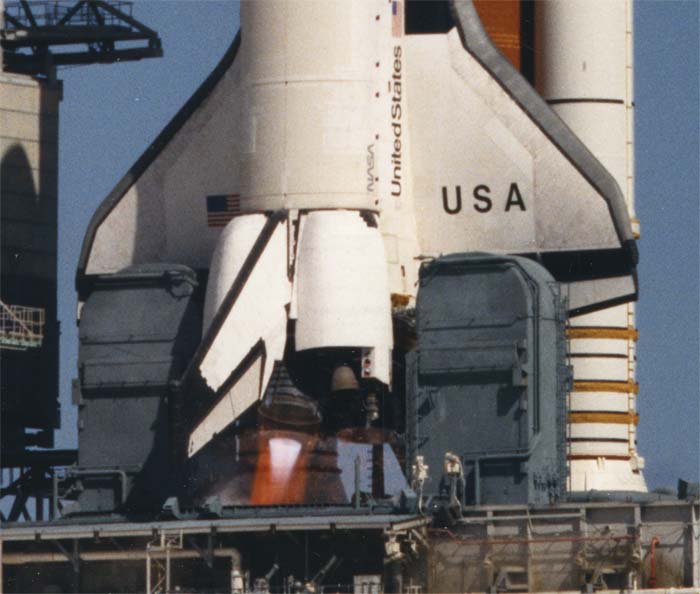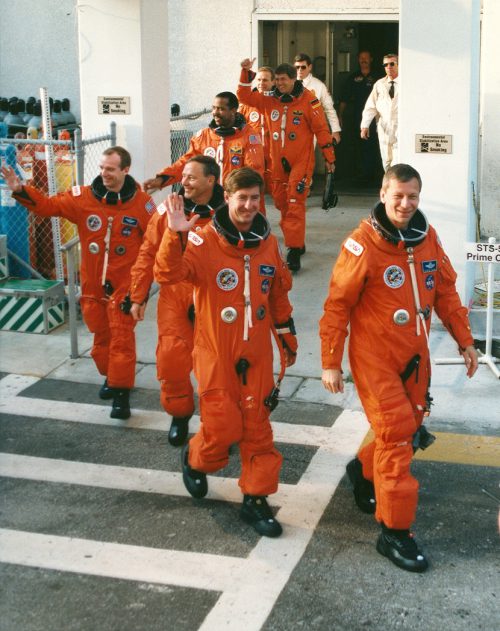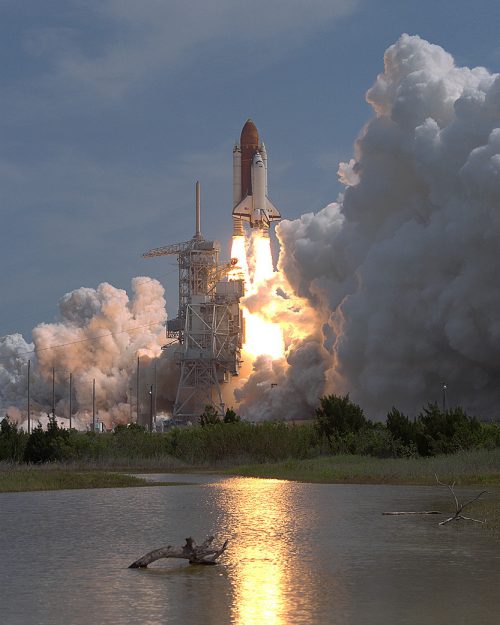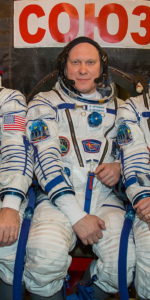
A quarter-century ago, in March 1993, shuttle Columbia stood ready on Pad 39A at the Kennedy Space Center (KSC) in Florida, awaiting liftoff on her 14th mission. Devoted to a variety of U.S. and German research investigations, the Spacelab-D2 payload had been delayed repeatedly in the aftermath of the Challenger tragedy and had already been postponed by more than a month, due to mechanical problems aboard Columbia herself. At last, on 22 March, the seven-man STS-55 crew—Commander Steve Nagel, Pilot Tom Henricks, Payload Commander Jerry Ross, Mission Specialists Charlie Precourt and Bernard Harris and Payload Specialists Ulrich Walter and Hans Schlegel—departed their quarters for the pad…and one of the most hazardous countdowns in shuttle history.
Video Credit: CNN
The nine-day flight had been beset by problems since earlier in the year. Firstly, questions arose over a suspicion that Columbia’s trio of Space Shuttle Main Engines (SSMEs) carried obsolete tip-seal retainers on the blades of their high-pressure liquid oxygen turbopumps. If they were old-style retainers, they needed to be checked before each mission, but if they were new ones they could fly several times without inspection. Certainty could not be established from the relevant paperwork, so the retainers were removed and inspected. It turned out that they were of the “newer” variety, but by the time the SSMEs were back in place the launch had been unavoidably postponed from late February until mid-March.
More trouble was afoot when a flex-hose in the shuttle’s aft compartment burst, spilling hydraulic fluid and forcing another delay. An Atlas I rocket from neighboring Cape Canaveral Air Force Station created competition for Eastern Range tracking assets, which eventually pushed STS-55 towards the end of March. In the small hours of the 22nd, Nagel and his men departed the Operations & Checkout (O&C) Building, bound for the pad and an anticipated T-0 at 9:51 a.m. EDT. The countdown proceeded with exceptional smoothness and at T-31 seconds, as intended, the shuttle’s on-board computers assumed primary command of all vehicle critical functions.

Six and a half seconds before launch, the ignition sequence of the SSMEs got underway, with its familiar, low-pitched rumble. However, within three seconds, all three engines abruptly shut down. It would later be determined that a liquid oxygen preburner check valve in the No. 3 engine had leaked in the final seconds, causing its purge system to be pressurized above the maximum redline level of 50 psi. With the No. 3 engine having incompletely ignited, Columbia’s computers commanded all three to shut down, in a so-called Redundant Set Launch Sequencer (RSLS) abort. The cause of the abort was a tiny shard of rubber, lodged in an engine propellant valve.
With unburnt hydrogen still lingering underneath the hot engine bells, the risk of a fire or explosion was very real. Seconds after the shutdown, the launch pad’s “white room” was automatically moved into position, alongside Columbia’s crew access hatch, preparatory to an evacuation, known as a “Mode One Egress”. Although the astronauts had trained to escape from a pad abort and slide to a fortified bunker, the danger of having them evacuate Columbia and run through an invisible hydrogen holocaust prompted controllers to instruct them to remain aboard the orbiter.

For 40 tense minutes, Nagel and his crew remained strapped into their seats as ground personnel deactivated all electronic components. Paramedics were rushed to the pad as a precautionary measure, but for the astronauts all was well—albeit eerily still—within the swaying cabin. “I’d convinced myself,” Nagel said, “and all my crew that we were going to fly.” When the brief noise of the engines died, he called over the intercom to announce the abort to his crewmates. “I wouldn’t call it fear,” he said later about those adrenaline-charged moments. “There’s a couple of moments wondering what’s happened, because all you see on-board are red lights, indicating an engine shutdown. You know the computers shut down the engines, but you don’t know why or exactly what went wrong with them.”
The situation was equally tense in the Launch Control Center (LCC), where ashen-faced Launch Director Bob Sieck watched the proceedings. “Your initial reaction,” he said in the aftermath of the abort, “is to make sure there are no fuel leaks or that there’s nothing that’s broken that’s causing a hazardous situation. Really, it was one of those nice, boring countdowns … until the last few seconds. What did work, and worked very well, were the safety systems on-board. As a result, the crew is safe and the vehicle is on the pad and safe as well.” Nonetheless, the STS-55 crew emerged from the orbiter looking visibly shaken by the incident. A month would elapse before Columbia rocketed smoothly into orbit on 26 April 1993, but the RSLS abort suffered by Steve Nagel and his men provided a stark reminder of the inherent dangers involved in launching shuttle crews into orbit.






A stark reminder of the infamous Gemini 6 launch abort in December, 1965. Spit-second decision making put to the test. Courageous!
That’s the trouble with sts.too complex.personally having read challenger report, I think only cmdr.Spock and Mr.data, from star trek, could have made the shuttle achieve its stated goals
The Columbia’s aborted launch attempt must have been terrifying for the crew onboard. I can’t imagine how horrible the team at the Launch Control Center must have felt, letting the crew board and try to launch in a shuttle with so many issues. It sounds like the tech team didn’t do their due diligence, and if the crew hadn’t made such a quick decision on their own, they could have lost their lives. It’s great that this event can serve as a reminder of the safety measures needed to be taken when launching people into space.
It’s great that it is a reminder instead of a memorial. What’s not great is using these reminders as a lever to slow roll America’s human space flight capability by entrenched interests.